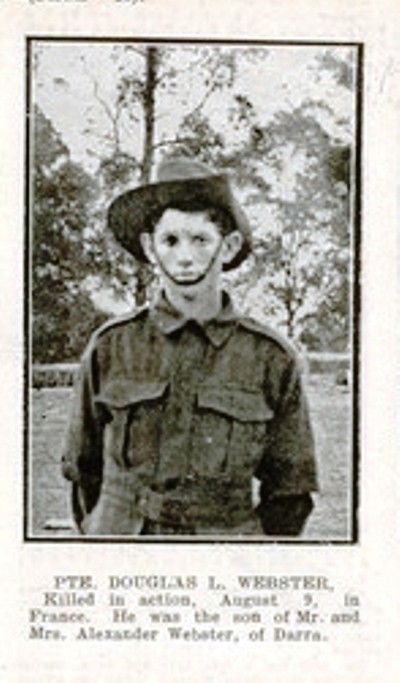
Douglas Lennox Webster. Queenslander, 21 September 1918, p.28.
Guest Blogger: Ian Lang, researcher, Graceville War Memorial
Douglas Webster was one of four brothers born in and around the Southern Darling Downs. Douglas was born at Tannymorel near Warwick. For most of Douglas Webster’s military career he was known as Alexander as this was the name under which he enlisted. It was not until after his death that his mother wrote to Base Records to inform them that his real name was Douglas Lennox Webster (she included a copy of his birth certificate). She also stated that his age at the time of his death was 18 years and six months. Given that he enlisted in December 1915 and was killed in action in August 1918, it would seem that Douglas was just shy of his sixteenth birthday when he enlisted. His mother’s letter confirms this stating that he was “to (sic) young” and he used his brother's name.
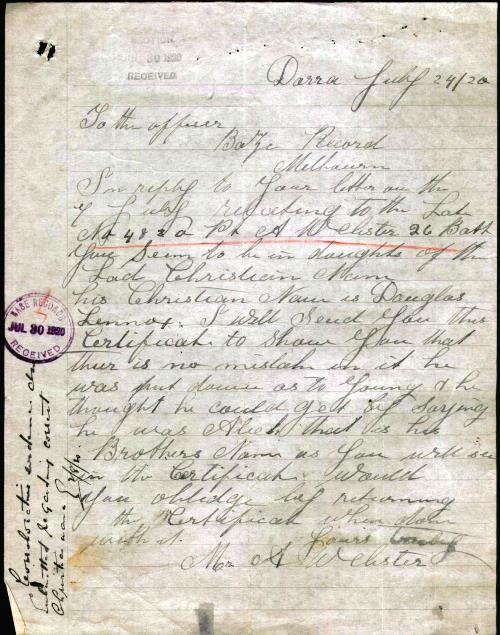
Letter from Mrs A. Webster to Base Records in Melbourne, 24 July 1920. Source: Australian National Archives.
On Douglas’s enlistment papers he gave his occupation as band cutter although his mother, when completing the Roll of Honour card, gave his occupation as railway porter. Douglas was drafted as a reinforcement in the 26th Battalion. The 26th was originally raised at Enoggera in March 1915, as a Queensland and Tasmanian battalion, and saw service on Gallipoli before being reorganised in Egypt prior to service on the Western Front.
In April 1916, Douglas embarked on the ship RMS Mooltan in Sydney enroute for England. He was admitted to the hospital on board the transport ship with V.D. where he spent 17 days. This would not be the only time Douglas stepped outside the boundaries. The journey to England was quite long, probably due to the route going via the Cape of Good Hope to avoid German submarines in the Mediterranean.
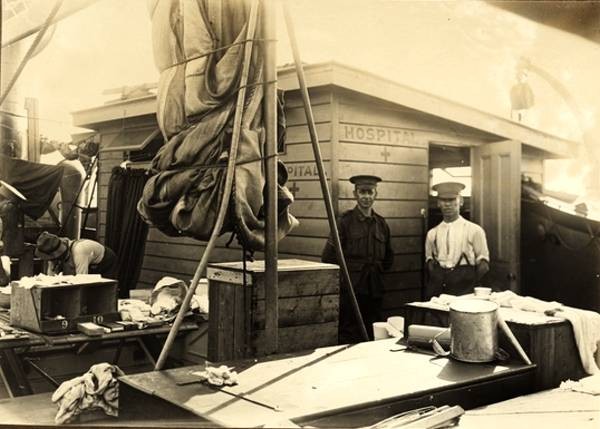
Transportable field hospital which was fully assembled on board the RMS Mooltan, 1915. Image from the website "The Old Peninsular & Oriental Steam Navigation Company", c. 1835-1972.
By December of 1916, young Douglas was in the Australian depot at Etaples where he was charged with “gathering wood outside segregation camp contrary to standing orders” and fined seven days pay. By February 1917 Douglas had joined his battalion. In June of that year he spent two weeks at the army sniping school. Soon after rejoining the battalion, Douglas was again before the Commanding Officer, this time for “Neglect to obey orders” and was sentenced to 7 days Field Punishment #2 (Field Punishment #2 meant that the offender would have to be shackled with cuffs for two hours in every 24) In the ensuing months, Douglas ran afoul of his superiors for disobeying orders while on a work party and using improper language to an NCO, for which he received a total of 14 days FP#2.
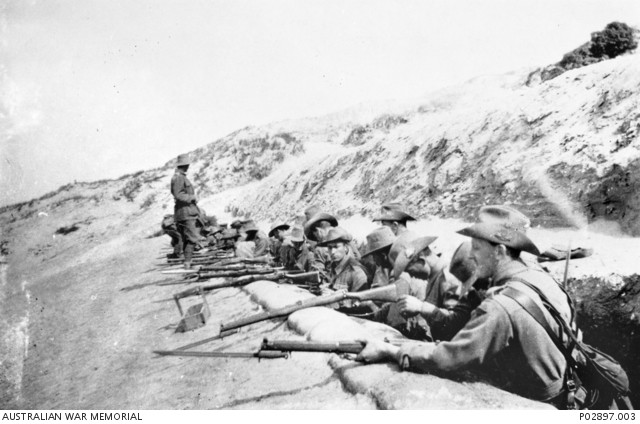
Soldiers training at Etaples, 1916. Image from the Australian War Memorial, Image No. P02897.003
After the German advances in the spring of 1918 were halted near Villers Bretonneux, Foch, the Supreme Allied Commander planned a huge counter offensive that he hoped would drive the enemy back to the Hindenburg Line. However, unlike the tactics that were employed on the Somme in 1916, by 1918 commanders had learnt a lot about mounting a successful attack. The 26th Battalion diary for August of 1918 demonstrates the detail in the planning, containing maps of artillery barrages, aerial photo reconnaissance photos and briefing notes for tank commanders.
This new coordinated method of warfare, employing infantry, armour, aircraft and artillery, which had been pioneered by General Monash, ANZAC Corps Commander, earlier in the year, proved to be decisive in the action to come. The 26th had been practicing infantry advances with tanks in preparation for their role in the drama throughout the early days of August. The great offensive began on 8th August and the following day, Douglas Webster was reported as killed in action. Ludendorff, the German commander would later describe the 8th August as “the blackest day.”
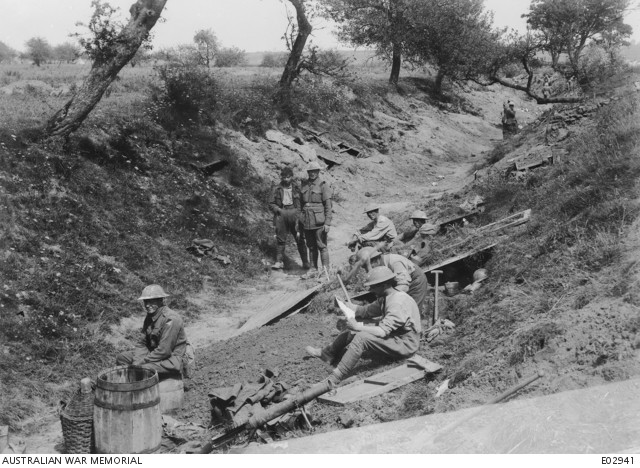
Men of the 26th Battalion resting in Framerville, France, not far from the front line, August 1918. Australian War Memorial photograph, E02941.
Douglas was probably buried on the battlefield where he fell as some time later his remains were exhumed and he was laid to rest at Heath Cemetery, Harbonnieres, along with 983 other Australians. He is in good company as amongst the fallen at Heath Cemetery are two V.C. winners as well as a D.S.O. and a Military Medal. His mother gave his age when killed as 18 years and 6 months. His father asked that the following words be inscribed on his grave:
“Safe in the arms of Jesus’ Safe in his gentle breast.”
Private Douglas Lennox Webster is also commemorated on the Oxley War Memorial in Brisbane.
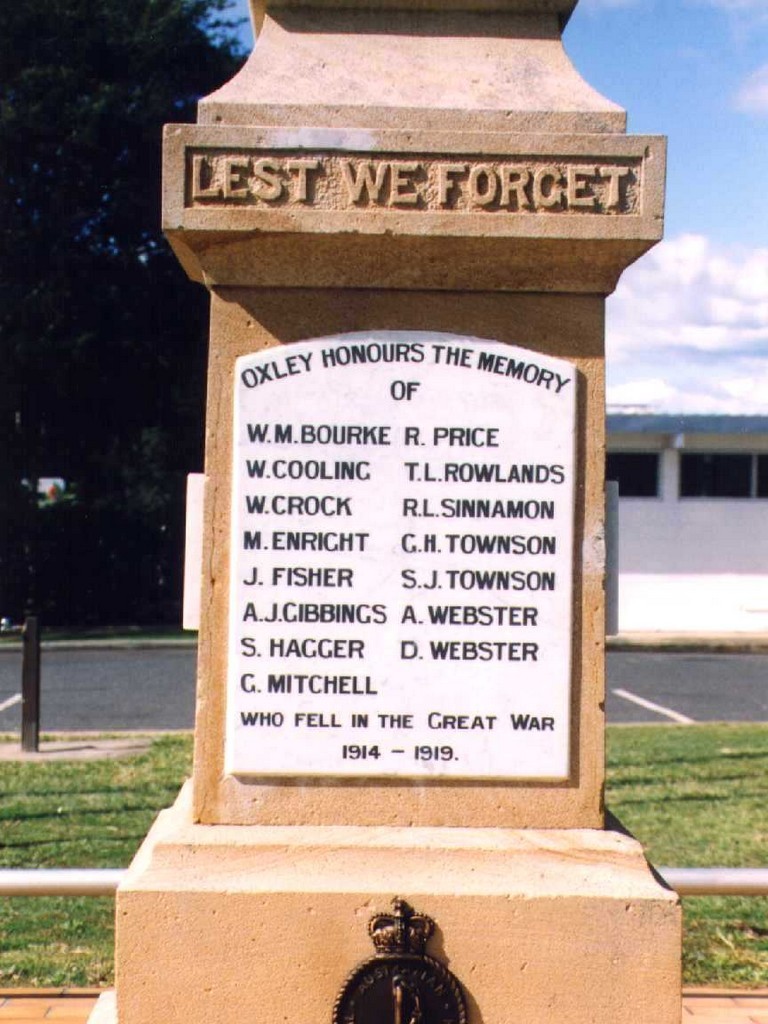
Oxley War Memorial, Brisbane. Source: Shirley and Trevor McIvor.
Ian Lang, researcher, Graceville War Memorial
Comments
Your email address will not be published.
We welcome relevant, respectful comments.